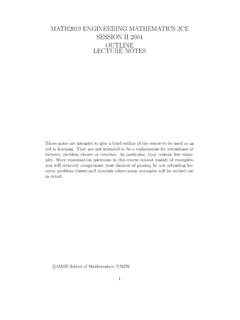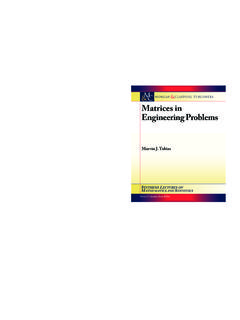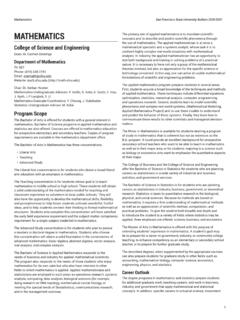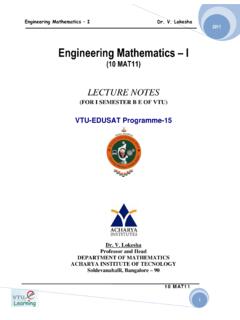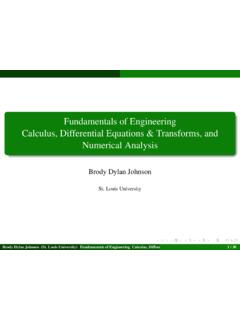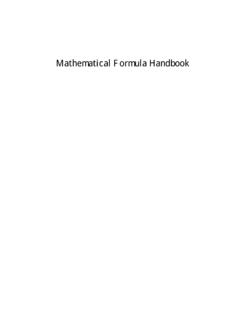Transcription of 1. First-order Ordinary Differential Equations
1 Advanced engineering mathematics 1. First-order Basic concept and Geometrical meaning of direction Separable Differential Exact Differential Equations and Integrating Linear Differential Equations and Bernoulli Orthogonal trajectories of Existence and uniqueness of solutions1. First-order Ordinary Differential EquationsAdvanced engineering mathematics 1. First-order Basic concepts and ideas Equations3y2+ y-4 = 0 y= ?where yis an unknown. Functionsf(x) = 2x3+ 4x,where xis a variable. Differential equationsA Differential equation is an equation contains one or several derivative of unknown functions (or dependent variables). For example,x= -2 , f(x) = -24x= -1 , f(x) = -6x= 0 , f(x) = 0x= 1 , f(x) = 6: : ( Ordinary Differential equation) (partial Differential equation)Advanced engineering mathematics 1. First-order ODEs3 There are several kinds of Differential Equations An Ordinary Differential equation (ODE) is an equation that contains one independent variable and one or several derivatives of an unknownfunction (or dependent variable), which we call y(x) and we want to determine from the equation.
2 For example,where yis called dependent variable andxis called independent variable. If a Differential equation contains one dependent variable and two or more independent variables, then the equation is a partial Differential equation (PDE). If Differential Equations contain two or more dependent variable and one independent variable, then the set of Equations is called a system of Differential engineering mathematics 1. First-order ODEs4 SummaryA Differential equation contains(1) one dependent variable and one independent variable an Ordinary Differential equation.(2) one dependent variable and two or more independent variable a partial Differential equation.(3) Two or more dependent variable and one independent variable a system of Differential (x) = 2 y1(x) - 4 y2(x) y1(x) = c14ex+ c2e-2xy2 (x) = y1(x) - 3 y2(x) y2(x) = c1ex+ c2e-2x(4) Two or more dependent variable and two or more independent variable a system of partial Differential Equations .
3 (rarely to see)Advanced engineering mathematics 1. First-order ODEs5 What is the purpose of Differential Equations ?Many physical laws and relations appear mathematically in the form of such Equations . For example, electronic circuit, falling stone, vibration, (R)Inductor (L)Electro-motive force (E)(1) Current Iin an RL-circuitLI + RI= E.(2) Falling stoney = g= constant.(3) PendulumL + g sin = IyAdvanced engineering mathematics 1. First-order ODEs6 Any physical situation involved motion or measure rates of change can be described by a mathematical model, the model is just a Differential transition from the physical problem to a corresponding mathematical model is called this course, we shall pay our attention to solve Differential Equations and don t care of is, the purposes of this course are thatgiven a Differential equation1. How do we know whether there is a solution ?2. How many solutions might there be for a DE, and how are they related?
4 3. How do we find a solution ?4. If we can t find a solution, can we approximate one numerically?Advanced engineering mathematics 1. First-order ODEs7 A First-order ODEis an equation involving one dependent variable, one independent variable, and the First-order derivative. For example,y + xy2 4 x3= 0(y )3/2+ x2 cos(xy ) = 0. A solution of a First-order ODEis a function which satisfies the equation. For example, y(x) = e2xis a solution of y 2y= (x) = x2is a solution of xy = 2y. A solution which appears as an implicit function, given in the form H(x, y) = 0, is called an implicit solution; for example x2+ y2-1 = 0 is an implicit solution of DE yy = contrast to an explicit solution with the form of y= f(x); for example, y= x2is an explicit solution of xy = engineering mathematics 1. First-order ODEs8 A general solution is a solution containing one arbitrary constant;for example, y= sinx+ cis a general solution of y = cosx.
5 A particular solution is a solution making a specific choice of constant on the general solution. Usually, the choice is made by some additional example, y= sinx- 2 is a particular solution of y = cosxwith thecondition y(0) = - 2. A Differential equation together with an initial condition is called an initial value problem. For example,y = f(x, y), y(x0) = y0,where x0and y0are given values. Problem of Section For example, xy = 3y, y(-4) = 16 y= cx3 Advanced engineering mathematics 1. First-order Geometrical meaning of y =f (x, y); Direction fields PurposeTo sketch many solution curves of a given DEwithout actually solving the Differential equation. Method of direction fieldsThe method applies to any Differential equation y = f(x,y).Assume y(x) is a solution of a given (x) has slope y (x0) = f (x0,y0) at (x0,y0).(i) draw the curves f(x,y) = k, kis a real constant. These curves are called isoclines of the original DE.(ii) along each isocline, draw a number of short line segments (called lineal element) of slope kto construct the direction field of the original DE.
6 (That is, the direction field is just the set of all connected lineal elements.)Advanced engineering mathematics 1. First-order ODEs10 Graph the direction field of the 1st-order DE y = xy.(i) draw the curves (isoclines) xy= ..-2, -1, 0, 1, 2, ..xyxy= 1xy= 2xy= 3xy= -3xy= -2xy= -1(ii) draw lineal elements on each isocline,xyxy= 1xy= 2xy= 3xy= -3xy= -2xy= -1 Advanced engineering mathematics 1. First-order ODEs11(a) By computer. (b) By field of y = xy. Problems of Section (iii) connect the related lineal elements to form the direction engineering mathematics 1. First-order Separable Differential Equations A DEis called separable if it can be written in the form ofg(y) y = f(x)org(y) dy = f(x) dxTo solve the equation by integrate both sides with x, SolveAdvanced engineering mathematics 1. First-order ODEs13 Solve value problemy + 5x4y2 = 0 with initial condition y(0)= engineering mathematics 1.
7 First-order ODEs14 Solvey = -2xy , y(0) = Ex. Solve Solve y = ky, y(0) = y0. Example of no separableDE(x-1)y = 3x2+ y. Note: There is no nice test to determine easily whether or not a 1st-order equation is engineering mathematics 1. First-order ODEs15 Reduction to separable forms Certain First-order Differential equation are not separable but can be made separable by a simple change of variables (dependent variable)The equation of the form can be made separable; and the form is called the R-1 Set , then y= ux(change of variables).step2. Differential y = u + xu (product differentiation formula).step3. The original DEstep4. integrate both sides of the replace uby engineering mathematics 1. First-order ODEs16 Solve 2xyy = byx2, we haveAdvanced engineering mathematics 1. First-order ODEs17 Ex. Solve initial value problemAdvanced engineering mathematics 1.
8 First-order ODEs18 Ex. Solve (2x -4y + 5) y + x -2y + 3= we setu=y/x, then the equation will become way by setting x -2y = v. ThenAdvanced engineering mathematics 1. First-order ODEs19R-2 formula Now we want to handle Differential Equations of the form, where a, b, c, g, e,and hare implies that ,which is R-1 formula when c = h= 0, and R-2 formula when c 0 or h 0. There are two ways to solve the equation:i. R-2 formula R-1 formula separable orii. R-2 formula separable (directly).Advanced engineering mathematics 1. First-order ODEs20 Case1. Suppose that ae bg variables x= X+ y = Y + to eliminate the effect of cand h,whereX andYare two new variables; and are two Differential equation becomesNow we choose and such thata + b + c = 0g + e + h = 0 Since ae bg 0 , then exist and satisfying these equationsSuch that {Advanced engineering mathematics 1. First-order ODEs21 Ex.}
9 , whereae bg= 2 *0 1 *1 x = X + andy =Y + to getSolving the system of linear equations2 + -1= 0 -2= 0 = 2 and = the equation becomes Let u= Y / X Y= Xu .Advanced engineering mathematics 1. First-order ODEs22 Since u= Y/ X,Since X= x - 2 and Y= y+ engineering mathematics 1. First-order ODEs23 Case2. Suppose that ae bg= .. (1)Since ae= bg( , ) .. (2).. (3)Advanced engineering mathematics 1. First-order ODEs24 engineering mathematics 1. First-order ODEs25 Problems of Section Differential equation becomesAdvanced engineering mathematics 1. First-order Exact Differential Equations Now we want to consider a DEasThat is, M(x,y)dx+ N(x,y)dy= 0. The solving principle can bemethod 1: transform this equation to be separable or R-1;method 2: to find a function u(x, y) such thatthe total Differential du is equal toMdx+Ndy. In the latter strategy, if uexists, then equation Mdx + Ndy= 0 is called exact, and u(x,y) is called a potential function for this Differential know that du= 0 u(x, y) = c ;it is just the general solution of the Differential engineering mathematics 1.
10 First-order ODEs27 How to find such an u ?since du== Mdx + Ndy,= Mand = to integrate M xor integrate N yto obtain u. Assume uis obtained by integrating M, then u(x, y) = Mdx+ k(y).step2. partial differentiate u y( , ), and to compare with Nto find kfunction. How to test Mdx + Ndy= 0 is exact or not ?Proposition (Test for exactness)If M, N, , and are continuous over a rectangularregion R, then Mdx + Ndy= 0 is exact for (x, y) in R if andonly ifin R .To findu, uis regarded as a function of two independent variables xand y. Advanced engineering mathematics 1. First-order ODEs28 Ex. Solve (x3+ 3xy2)dx+ (3x2y+ y3)dy= step: (testing for exactness)M= x3+ 3xy2, N= 3x2y+ y3It implies that the equation is step:u= Mdx+ k(y) = (x3+3xy2)dx+ k(y) = x4+ x2y2+ k(y)3rd step:Since = N 3x2y+ k (y) = 3x2y+ y3,k (y) = y3. That is k(y) = y4+ c*.Thus u(x,y) = (x4+ 6x2y2+ y4) + c*.The solution is then (x4+ 6x2y2+ y4) = is an implicit solution to the original DE.

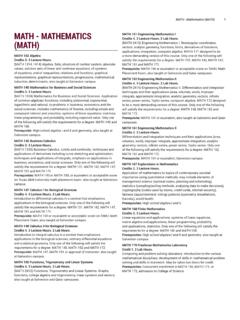
![[Engineering Mathematics]](/cache/preview/1/e/f/3/d/f/5/2/thumb-1ef3df52d76a8c1d51851076ed688d22.jpg)
